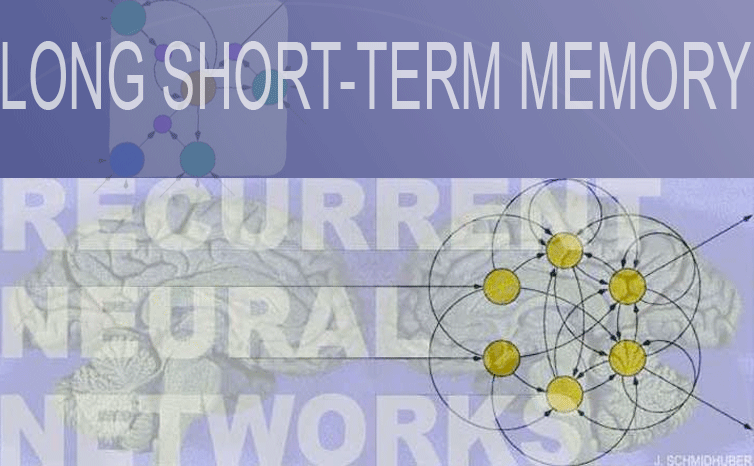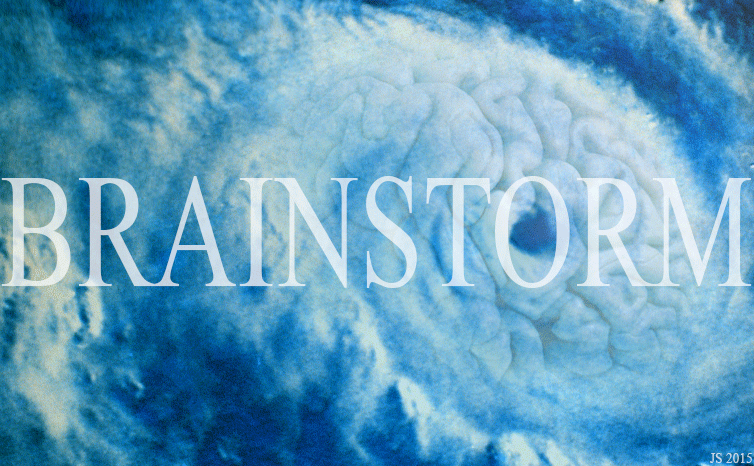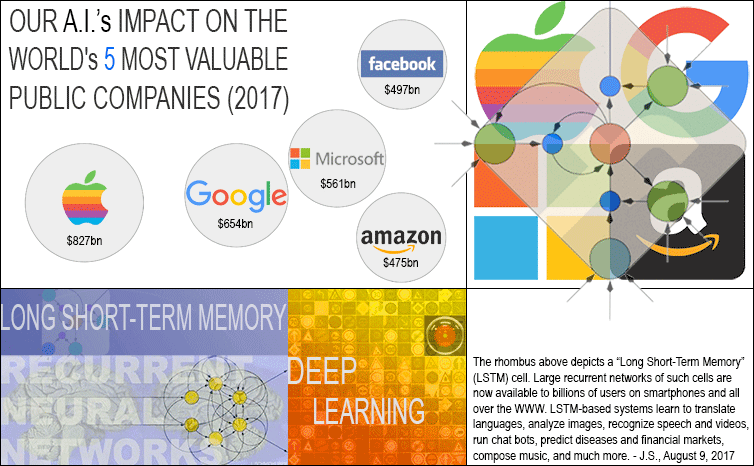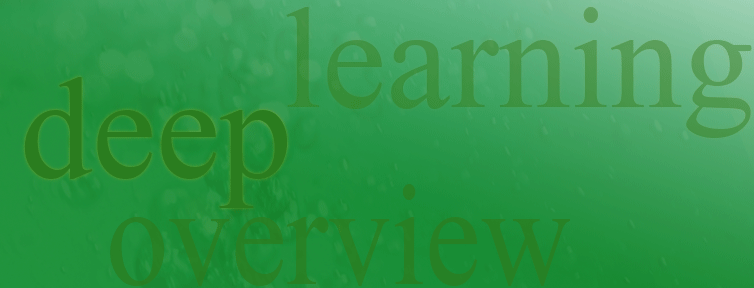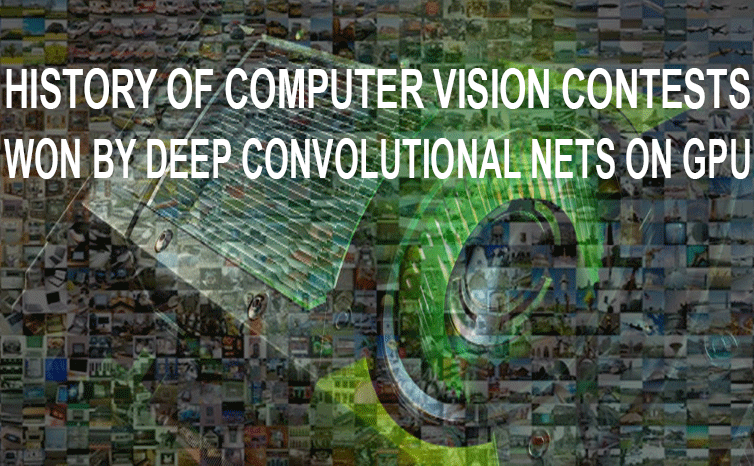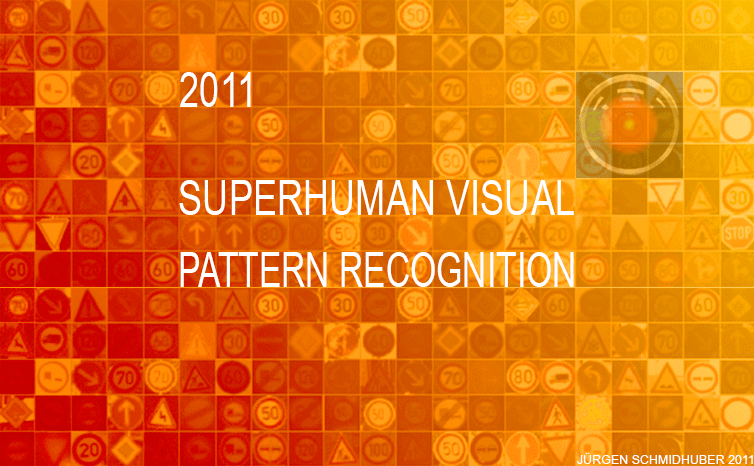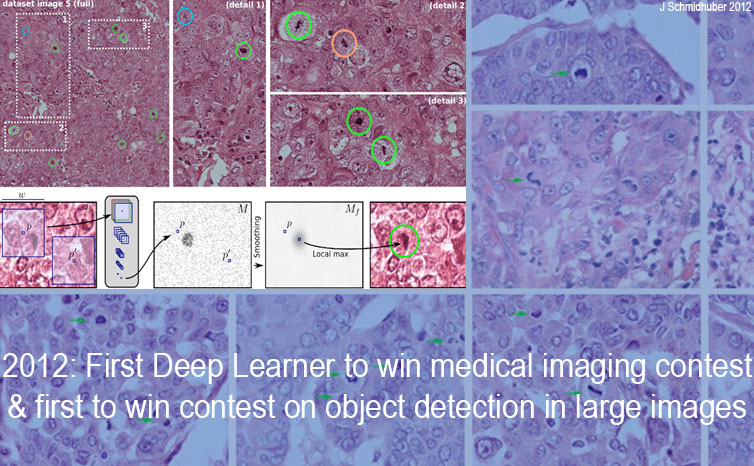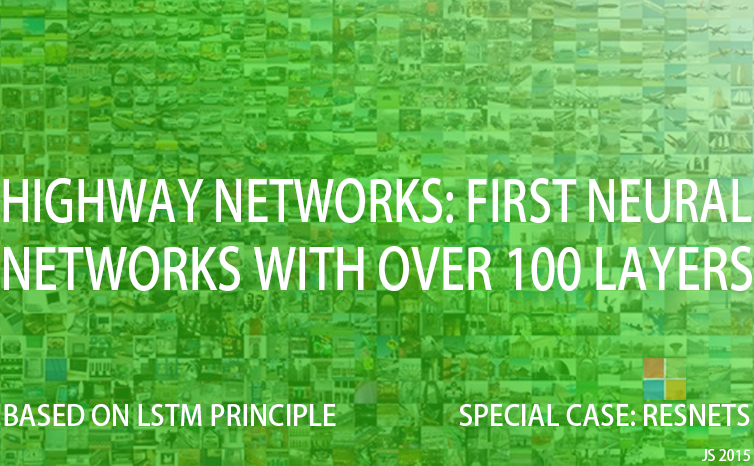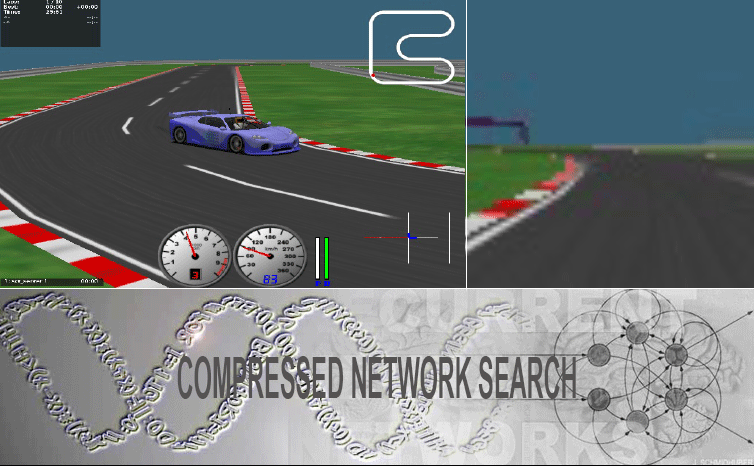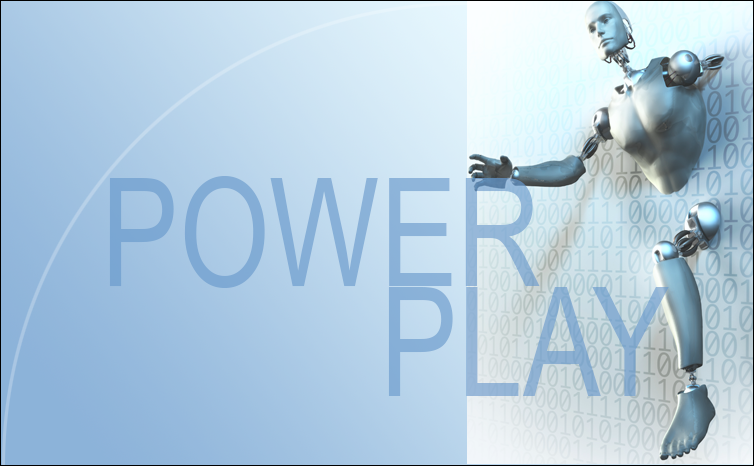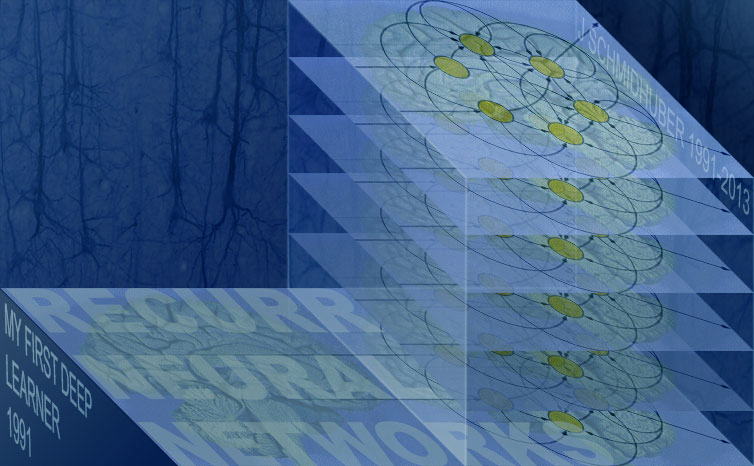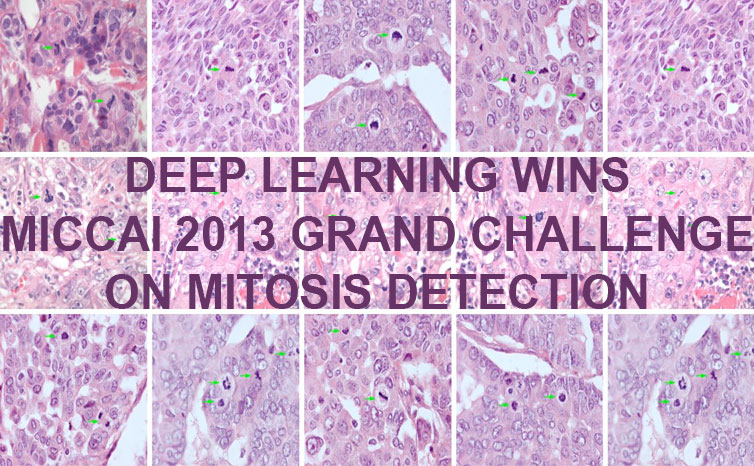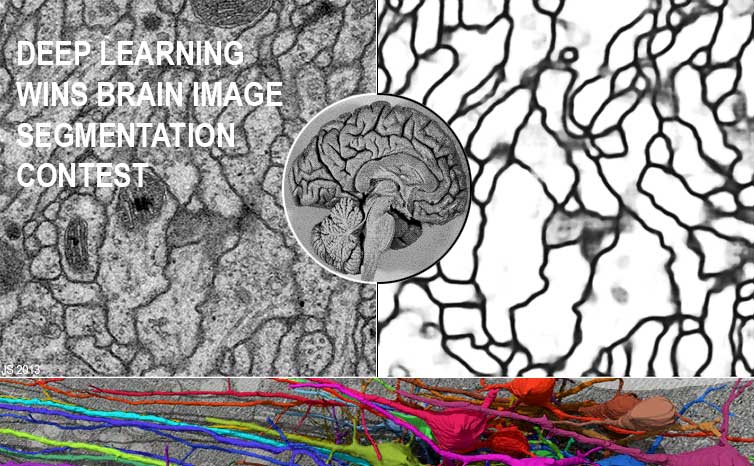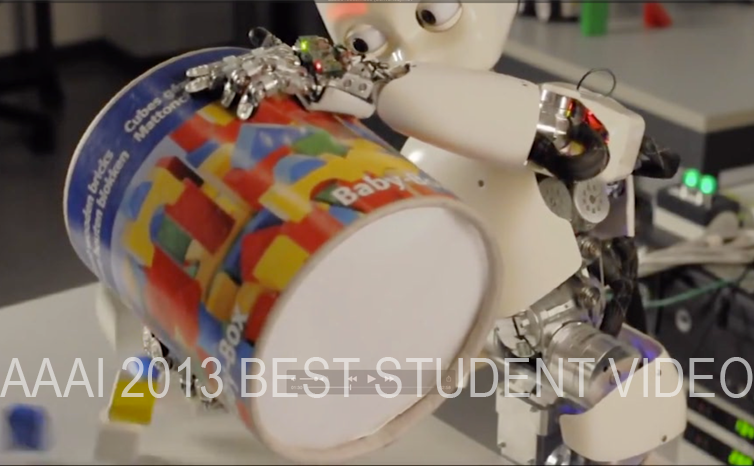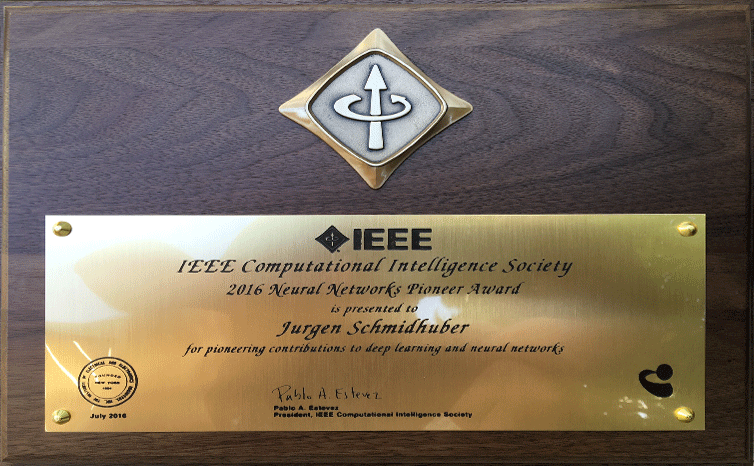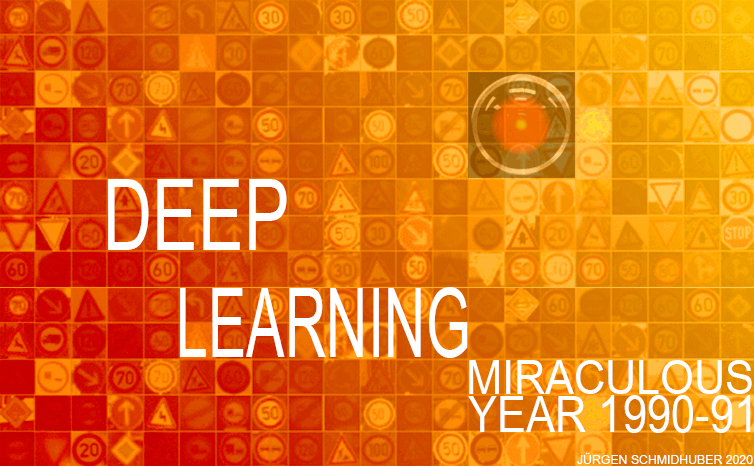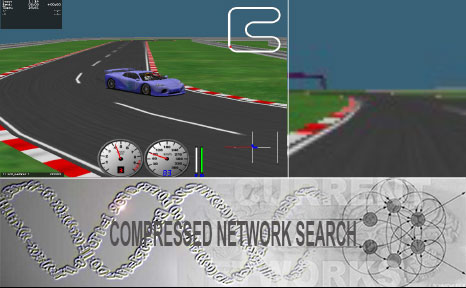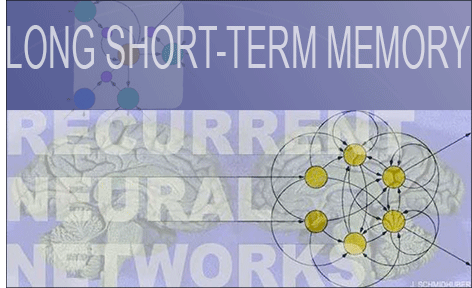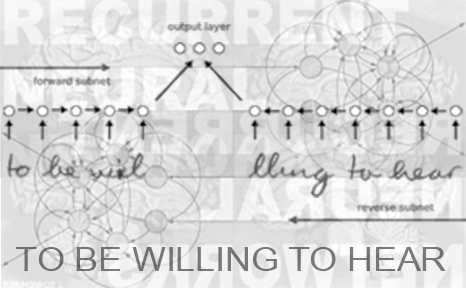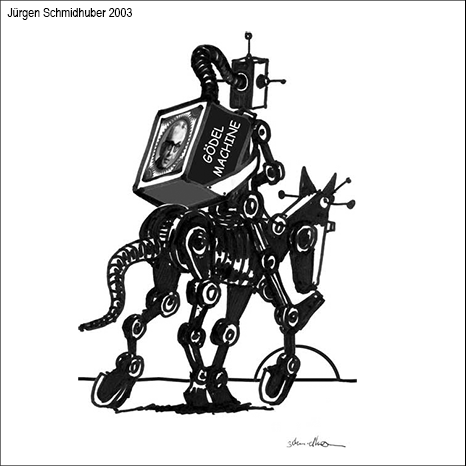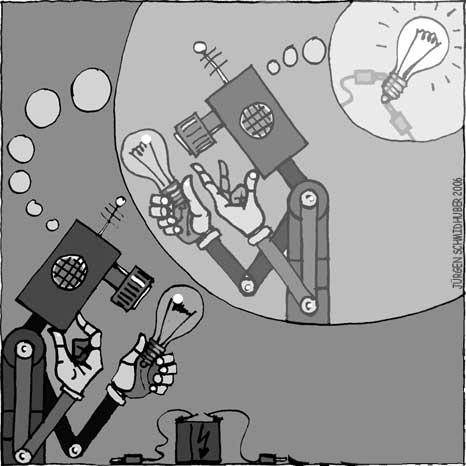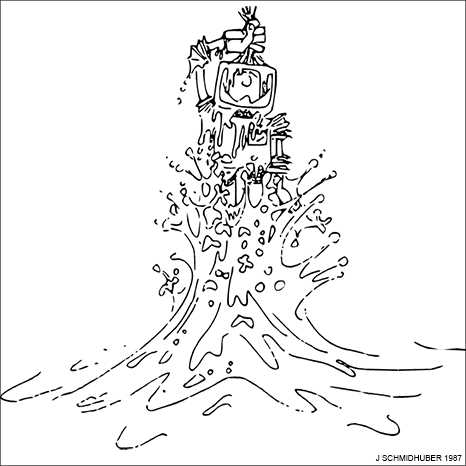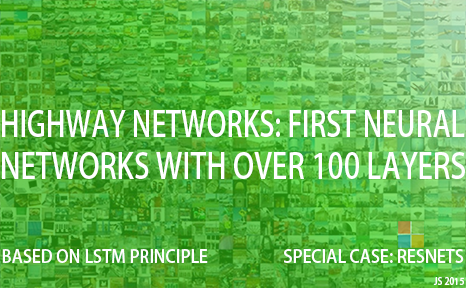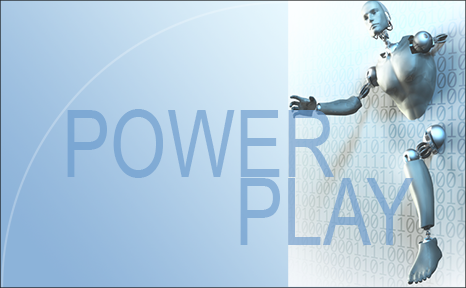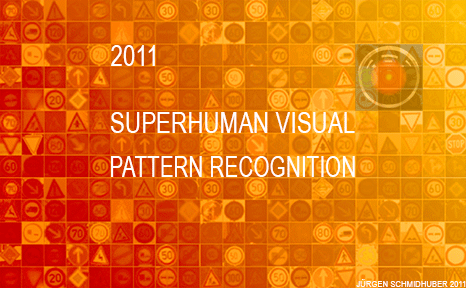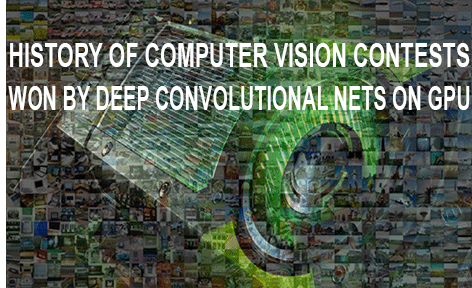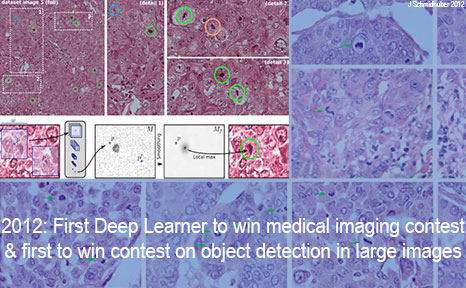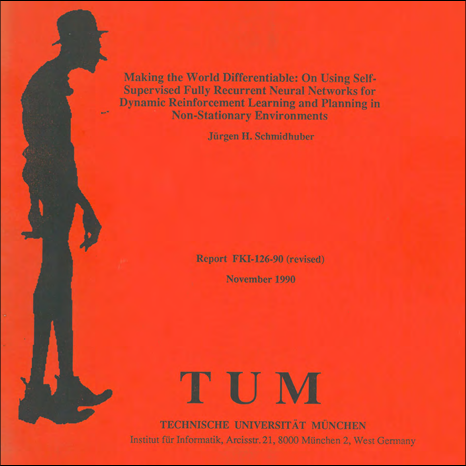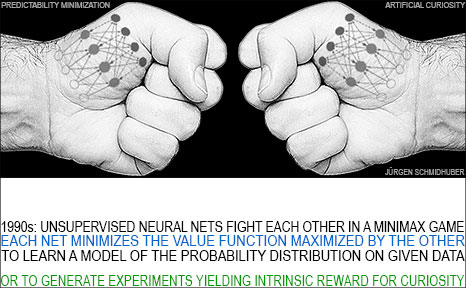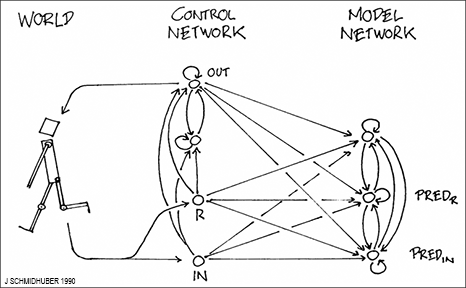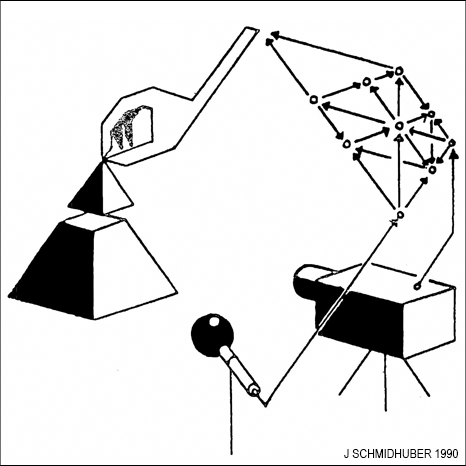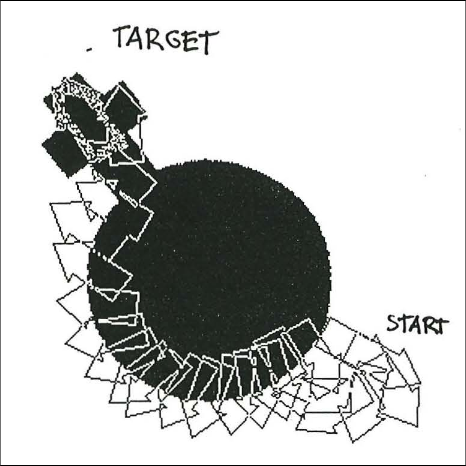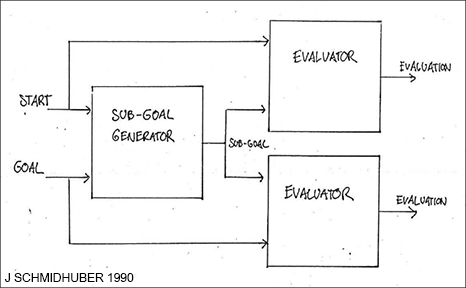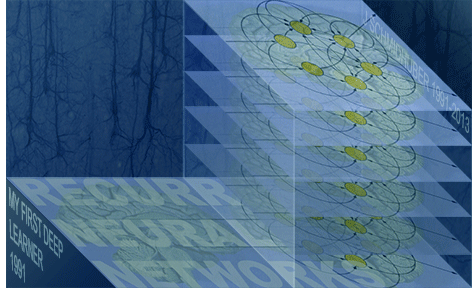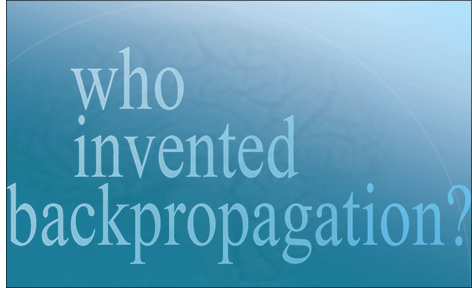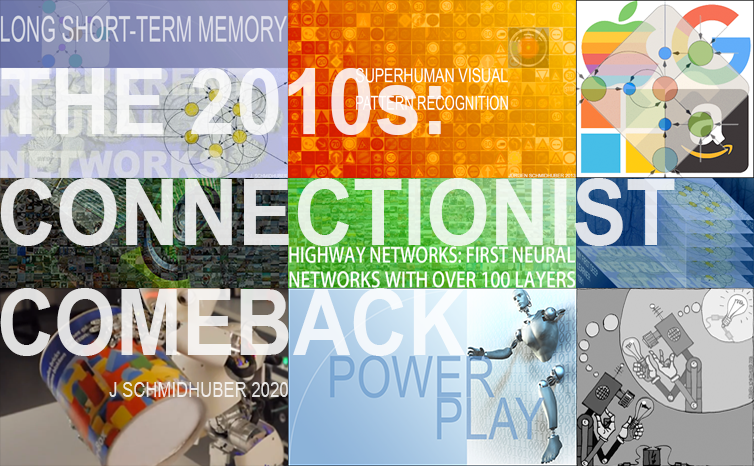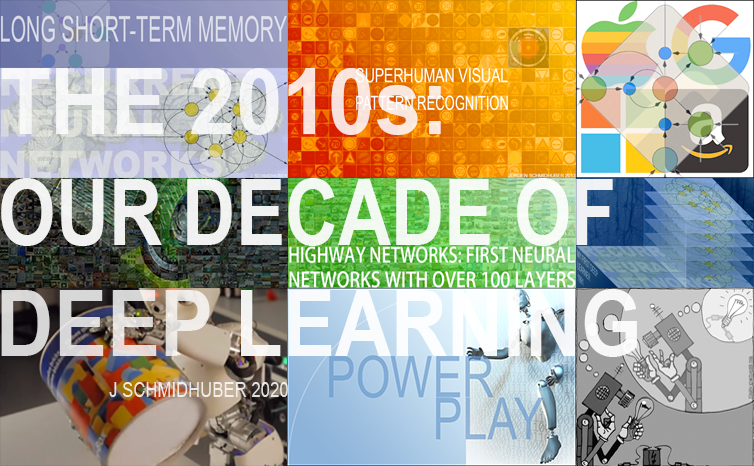
The 2010s: Our Decade of Deep Learning / Outlook on the 2020s
Jürgen Schmidhuber (02/20/2020)
A previous post [MIR] (2019) focused on our
Annus Mirabilis 1990-1991
at TU Munich. Back then we published many of the basic ideas that powered the Artificial Intelligence Revolution of the 2010s through Artificial Neural Networks (NNs) and Deep Learning. The present post is partially redundant but much shorter (a 7 min read), focusing on the recent decade's most important developments and applications based on our work, also mentioning related work, and concluding with an outlook on the 2020s, also addressing privacy and data markets. Here the table of contents:
Sec. 1: The Decade of Long Short-Term Memory
1. The Decade of Long Short-Term Memory (LSTM)
Much of AI in the 2010s was about the NN called Long Short-Term Memory (LSTM) [LSTM1-13] [DL4]. The world is sequential by nature, and LSTM has revolutionized sequential data processing, e.g., speech recognition, machine translation, video recognition, connected handwriting recognition, robotics, video game playing, time series prediction, chat bots, healthcare applications, you name it. By 2019, [LSTM1] got more citations per year than any other computer science paper of the past millennium. Below I'll list some of the most visible and historically most significant applications.
2009: Connected Handwriting Recognition.
Enormous interest from industry was triggered right before the 2010s when out of the blue
my PhD student Alex Graves won three connected handwriting competitions (French, Farsi, Arabic) at ICDAR 2009, the famous conference on document analysis and recognition. He used a combination of two methods developed in my research
groups at TU Munich and the Swiss AI Lab IDSIA: LSTM (1990s-2005) [LSTM1-6]
(which overcomes the famous vanishing gradient problem analyzed by my PhD student Sepp Hochreiter [VAN1] in 1991) and Connectionist Temporal Classification [CTC] (2006).
CTC-trained LSTM was the first recurrent NN or RNN [MC43] [K56]
to win any international contests.
CTC-Trained LSTM also was the First Superior End-to-End Neural Speech Recognizer.
Already in 2007, our team successfully applied CTC-LSTM to speech [LSTM4], also with hierarchical LSTM stacks [LSTM14]. This was very different from previous hybrid methods since the late 1980s which combined NNs and traditional approaches such as Hidden Markov Models (HMMs), e.g., [BW] [BRI] [BOU] [HYB12].
Alex kept using CTC-LSTM as a postdoc in Toronto [LSTM8].
CTC-LSTM has had massive industrial impact.
By 2015, it dramatically improved Google's speech recognition [GSR15] [DL4].
This is now on almost every smartphone.
By 2016, more than a quarter of the power of all those
Tensor Processing Units in Google's datacenters
was used for LSTM (and 5% for convolutional NNs) [JOU17].
Google's
on-device speech recognition of 2019
(not any longer on the server)
is still based on
LSTM.
See [MIR],
Sec. 4.
Microsoft, Baidu, Amazon, Samsung, Apple, and many other famous companies are using LSTM, too [DL4] [DL1].
2016: The First Superior End-to-End Neural Machine Translation was also Based on LSTM. Already in 2001, my PhD student Felix Gers showed that LSTM can learn languages unlearnable by traditional models such as HMMs [LSTM13]. That is, a neural "subsymbolic" model suddenly excelled at learning "symbolic" tasks!
Compute still had to get 1000 times cheaper, but by 2016-17, both Google Translate [GT16] [WU] (which mentions LSTM over 50 times) and Facebook Translate [FB17] were based on two connected LSTMs [S2S], one for incoming texts, one for outgoing translations - much better than what existed before [DL4]. By 2017, Facebook's users made 30 billion LSTM-based translations per week [FB17] [DL4]. Compare: the most popular youtube video (the song "Despacito") got only 6 billion clicks in 2 years. See [MIR],
Sec. 4.
LSTM-Based Robotics. By 2003, our team used LSTM for Reinforcement Learning (RL) and robotics, e.g., [LSTM-RL]. In the 2010s, combinations of RL and LSTM have become standard. For example, in 2018, an RL-trained LSTM was the core of OpenAI's Dactyl which learned to control a dextrous robot hand without a teacher [OAI1].
2018-2019: LSTM for Video Games. In 2019, DeepMind beat a pro player in the game of Starcraft, which is harder than Chess or Go [DM2] in many ways, using
Alphastar whose brain has a deep LSTM core trained by RL [DM3].
An RL-trained LSTM (with 84% of the model's total parameter count) also was the core of
OpenAI Five
which learned to defeat human experts in the
Dota 2 video game (2018) [OAI2] [OAI2a].
See [MIR],
Sec. 4.
The 2010s saw many additional LSTM applications, e.g., [DL1].
LSTM was used for healthcare,
chemistry, molecule design, lip reading [LIP1], stock market prediction, self-driving cars,
mapping brain signals to speech (Nature, vol 568, 2019),
predicting what's going on in nuclear fusion reactors (same volume, p. 526), etc. There is not enough space to mention everything here.
2. The Decade of Feedforward Neural Networks
LSTM is an RNN that can in principle implement any program that runs on your laptop. The more limited feedforward NNs (FNNs) cannot (although they are good enough for board games such as Backgammon [T94]
and Go [DM2] and Chess). That is, if we want to build an NN-based Artificial General Intelligence (AGI), then its underlying computational substrate must be something like an RNN. FNNs are fundamentally insufficient. RNNs relate to FNNs like general computers relate to mere calculators.
Nevertheless, our Decade of Deep Learning was also about FNNs, as described next.
2010: Deep FNNs Don't Need Unsupervised Pre-Training!
In 2009, many thought that deep FNNs cannot learn much without
unsupervised pre-training [MIR] [UN0-UN5].
But in 2010, our team with my
postdoc Dan Ciresan [MLP1]
showed that deep FNNs
can be trained by plain
backpropagation
[BP1] (compare [BPA]
[BPB] [BP2] [R7])
and do not at all require unsupervised
pre-training for important applications.
Our system set a new performance record [MLP1] on
the back then famous and widely used image recognition benchmark called MNIST.
This was achieved by greatly accelerating traditional FNNs on highly parallel
graphics processing units called GPUs. A reviewer called this a
"wake-up call to the machine learning community."
Today, very few commercial NN applications are still based on unsupervised pre-training
(used in my first deep learner of 1991).
See [MIR],
Sec. 19.
2011: CNN-Based Computer Vision Revolution. Our team in Switzerland (Dan Ciresan et al.)
greatly sped up the convolutional NNs (CNNs)
invented and developed by others since the 1970s [CNN1-4].
The first superior award-winning CNN, often called "DanNet,"
was created in 2011 [GPUCNN1,3,5].
It was a practical breakthrough. It was much deeper and faster than earlier GPU-accelerated
CNNs [GPUCNN].
Already in 2011, it showed that deep learning worked far better than the existing state-of-the-art for recognizing objects in images.
In fact, it
won 4 important computer vision competitions in a row
between May 15, 2011, and September 10, 2012 [GPUCNN5]
before a similar GPU-accelerated CNN of Univ. Toronto won the ImageNet 2012 contest [GPUCNN4-5] [R6].
At IJCNN 2011 in Silicon Valley, DanNet blew away the competition through the first superhuman visual pattern recognition in a contest. Even the New York Times mentioned this.
It was also the first deep CNN to win:
a Chinese handwriting contest (ICDAR 2011),
an image segmentation contest (ISBI, May 2012),
a contest on object detection in large images (ICPR, 10 Sept 2012),
at the same time a medical imaging contest on cancer detection.
(All before ImageNet 2012 [GPUCNN4-5] [R6].)
Our CNN image scanners were 1000 times faster than previous methods [SCAN],
with tremendous importance for health care etc. Today IBM, Siemens, Google and many startups are pursuing this approach. Much of modern computer vision is extending the work of 2011, e.g., [MIR], Sec. 19.
Already in 2010, we introduced our
deep and fast GPU-based NNs to Arcelor Mittal, the world's largest steel maker,
and were able to greatly improve steel defect detection through CNNs [ST]
(before ImageNet 2012).
This may have been the first Deep Learning breakthrough in heavy industry,
and helped to jump-start our company NNAISENSE.
The early 2010s
saw several other applications of our Deep Learning methods.
Through my students
Rupesh Kumar Srivastava and Klaus Greff,
the LSTM principle also
led to
our Highway Networks [HW1] of May 2015, the first working very deep FNNs with hundreds of layers. Microsoft's popular ResNets [HW2] (which won the
ImageNet 2015 contest) are a special case thereof.
The earlier Highway Nets perform roughly as well as ResNets on ImageNet [HW3].
Highway layers are also often used for natural language processing, where the simpler residual layers do
not work as well [HW3].
3. LSTMs & FNNs, especially CNNs. LSTMs v FNNs
In the recent Decade of Deep Learning,
the recognition of static patterns (such as images)
was mostly driven by CNNs (which are FNNs; see Sec. 2),
while sequence processing (such as speech, text, etc.) was mostly driven by LSTMs (which are RNNs [MC43] [K56]; see Sec. 1).
Often CNNs and LSTMs were combined, e.g., for video recognition. FNNs and LSTMs also
invaded each other's territories on occasion. Two examples:
1. Multi-dimensional LSTM [LSTM15] does not suffer from the limited fixed patch size of CNNs and excels at certain computer vision
problems [LSTM16]. Nevertheless, most of computer vision is still based on CNNs.
2. Towards the end of the decade,
despite their limited time windows,
FNN-based Transformers [TR1] [TR2]
started to excel at Natural Language Processing,
a traditional LSTM domain (see Sec. 1).
Nevertheless, there are still many language tasks that LSTM can
rapidly learn to solve quickly [LSTM13]
(in time proportional to sentence length)
while plain Transformers can't.
Business Week called LSTM "arguably the most commercial AI achievement" [AV1].
As mentioned above,
by 2019, [LSTM1] got more citations per year than all other computer science papers of the past millennium [R5]. The record holder of the new millennium [HW2] is an FNN related to LSTM: ResNet [HW2] (Dec 2015) is a special case of our Highway Net (May 2015) [HW1], the FNN version of vanilla LSTM [LSTM2].
4. GANs: the Decade's Most Famous Application of our Curiosity Principle (1990)
Another concept that has become very popular in the 2010s are Generative Adversarial Networks (GANs), e.g., [GAN0] (2010)
[GAN1] (2014). GANs are an instance of my popular
adversarial
curiosity principle
from 1990 [AC90, AC90b] (see also survey [AC09]). This principle works as follows. One NN probabilistically generates outputs, another NN sees those outputs and predicts environmental reactions to them. Using gradient descent, the predictor NN minimizes its error, while the generator NN tries to make outputs that maximize this error. One net's loss is the other net's gain. GANs are a special case of this where the environment simply returns 1 or 0 depending on whether the generator's output is in a given set [AC19].
(Other
early adversarial machine learning settings [S59] [H90]
neither involved unsupervised NNs nor were about modeling data nor used gradient descent [AC19].)
Compare [SLG] [R2] [AC18] and [MIR],
Sec. 5.
5. Other Hot Topics of the 2010s: Deep Reinforcement Learning, Meta-Learning, World Models, Distilling NNs, Neural Architecture Search, Attention Learning, Fast Weights, Self-Invented Problems ...
In July 2013, our
Compressed Network Search [CO2]
was the
first deep learning model to successfully learn control policies
directly from high-dimensional sensory input (video) using deep reinforcement learning (RL) (see survey in Sec. 6 of [DL1]),
without any
unsupervised pre-training
(extending earlier work on large NNs with
compact codes, e.g., [KO0] [KO2]; compare more recent work [WAV1] [OAI3]).
This also helped to jump-start our company NNAISENSE.
A few months later, neuroevolution-based RL (see survey [K96])
also successfully learned to play Atari games [H13].
Soon afterwards, the company
DeepMind also had a Deep RL system for high-dimensional sensory input [DM1] [DM2].
See [MIR],
Sec. 8.
By 2016, DeepMind had a famous superhuman Go player [DM4].
The company was founded in 2010, by some counts the decade's first year. The first DeepMinders with AI publications and PhDs in computer science came from my lab: a co-founder and employee nr. 1.
Our work since 1990 on RL and planning based on a combination of two RNNs called the controller and the world model [PLAN2-6] also has become popular in the 2010s. See [MIR],
Sec. 11.
(The decade's end also saw a very simple yet novel approach to the old problem of RL [UDRL].)
For decades, few have cared for our work on meta-learning or learning to learn since 1987, e.g., [META1] [FASTMETA1-3] [R3]. In the 2010s,
meta-learning has finally become
a hot topic [META10] [META17].
Similar for our work since 1990 on Artificial Curiosity & Creativity
[MIR] (Sec. 5, Sec. 6)
[AC90-AC10]
and Self-Invented Problems
[MIR] (Sec. 12)
in POWERPLAY style (2011) [PP] [PP1] [PP2].
See, e.g., [AC18].
Similar for our work since 1990 on Hierarchical RL, e.g. [HRL0]
[HRL1] [HRL2] [HRL4]
(see [MIR],
Sec. 10),
Deterministic Policy Gradients [AC90], e.g., [DPG]
[DDPG] (see [MIR],
Sec. 14),
and Synthetic Gradients
[NAN1-NAN4], e.g.,
[NAN5]
(see [MIR],
Sec. 15).
Similar for our work since 1991
on encoding data by factorial disentangled representations
through adversarial NNs [PM2] [PM1]
and other methods [LOC]
(compare [IG] and [MIR],
Sec. 7),
and on end-to-end-differentiable systems that learn by gradient descent to quickly manipulate NNs with Fast Weights [FAST0-FAST3a] [R4], separating storage and control like in traditional computers,
but in a fully neural way (rather than in a hybrid fashion [PDA1] [PDA2] [DNC] [DNC2]).
See [MIR],
Sec. 8.
Similar for our work since 2009 on Neural Architecture Search for LSTM-like architectures
that outperform vanilla LSTM in certain applications [LSTM7], e.g., [NAS], and our work
since 1991 on compressing or distilling NNs into other NNs [UN0] [UN1], e.g., [DIST2] [R4].
See [MIR],
Sec. 2.
Already in the early 1990s, we had both of the now common types of neural sequential attention:
end-to-end-differentiable "soft" attention (in latent space) [FAST2]
through multiplicative units within networks [DEEP1-2] (1965),
and
"hard" attention (in observation space) in
the context of RL [ATT0] [ATT1].
This led to lots of follow-up work.
In the 2010s, many have used sequential attention-learning NNs.
See [MIR],
Sec. 9.
Many other concepts of the previous millennium [DL1] [MIR]
had to wait for the much faster computers of the 2010s to become popular.
As mentioned in Sec. 21 of ref [MIR], surveys from the Anglosphere
do not always make clear [DLC]
that Deep Learning was invented where English is not an official language. It started in 1965 in the Ukraine (back then the USSR) with the first nets of arbitrary depth that really learned [DEEP1-2] [R8]. Five years later, modern
backpropagation
was published "next door" in Finland (1970) [BP1]. The basic deep convolutional NN architecture (now widely used) was invented in the 1970s in Japan [CNN1], where NNs with convolutions were later (1987) also combined with "weight sharing" and backpropagation [CNN1a]. We are standing on the shoulders of these authors and many others - see 888 references in ref [DL1].
Of course,
Deep Learning is just a small
part of AI, in most applications limited to passive
pattern recognition.
We view it as a by-product of our research on more general
artificial intelligence, which includes
optimal universal learning machines such
as the Gödel machine
(2003-),
asymptotically optimal search for programs
running on general purpose computers such as RNNs, etc.
AIs are trained by data. If it is true that data is the new oil, then it should have a price, just like oil. In the 2010s,
the major surveillance
platforms (e.g., Sec. 1) [SV1] did not offer you any money for your data and the resulting loss of privacy.
The 2020s, however, will see attempts at creating efficient data markets to figure out your data's true financial value through the interplay between supply and demand. Even some of the
sensitive medical data
will not be priced by governmental regulators but by
patients (and healthy persons) who own it and who may sell parts thereof as micro-entrepreneurs in a healthcare data market [SR18] [CNNTV2].
Are surveillance and loss of privacy inevitable consequences of increasingly complex societies? Super-organisms such as cities and states and companies consist of numerous people, just like people consist of numerous cells. These cells enjoy little privacy. They are constantly monitored by specialized "police cells" and "border guard cells": Are you a cancer cell? Are you an external intruder, a pathogen? Individual cells sacrifice their freedom for the benefits of being part of a multicellular organism.
Similar for super-organisms such as nations [FATV].
Over 5000 years ago, writing enabled recorded history and thus became its
inaugural and most important invention.
Its initial purpose,
however, was to facilitate surveillance, to track citizens and their tax payments. The more complex a super-organism, the more comprehensive its collection of information about its components.
200 years ago, at least the parish priest in each village knew everything about all the village people, even about those who did not confess, because they appeared in the confessions of others. Also, everyone soon knew about the stranger who had entered the village, because some occasionally peered out of the window, and what they saw got around. Such control mechanisms were temporarily lost through anonymization in rapidly growing cities, but are now returning with the help of new surveillance devices such as smartphones as part of digital nervous systems that tell companies and governments a lot about billions of users
[SV1] [SV2].
Cameras and drones [DR16] etc. are becoming tinier all the time and ubiquitous; excellent recognition
of faces and gaits etc. is becoming cheaper and cheaper, and soon many will use it to identify others anywhere on earth - the big wide world will not offer any more privacy than the local village. Is this good or bad? Anyway, some nations may find it easier than others to become more complex kinds of super-organisms at the expense of the privacy rights of their constituents [FATV].
In the 2010s, AI excelled in virtual worlds, e.g., in video games, board games, and especially on the major WWW platforms (Sec. 1). Most AI profits were in marketing. Passive pattern recognition through NNs helped some of the
most valuable companies
such as Amazon & Alibaba & Google & Facebook & Tencent to keep you longer on their platforms, to predict which items you might be interested in, to make you click at tailored ads etc.
However, marketing is just a tiny part of the world economy. What will the next decade bring?
In the 2020s, Active AI will more and more invade the real world, driving industrial processes and machines and robots, a bit like in the movies. (Better self-driving cars [CAR1] will be part of this, especially fleets of simple electric cars with small & cheap batteries [CAR2].) Although the real world is much more complex than virtual worlds, and less forgiving, the coming wave of "Real World AI" or simply "Real AI" will be much bigger than the previous AI wave, because it will affect all of production, and thus a much bigger part of the economy. That's why
NNAISENSE is all about Real AI.
Some claim that big platform companies with lots of data from many users will dominate AI. That's absurd. How does a baby learn to become intelligent? Not "by downloading lots of data from Facebook" [NAT2]. No, it learns by actively creating its own data through its own self-invented experiments with toys etc, learning to predict the consequences of its actions, and using this predictive model of physics and the world to become a better and better planner and problem solver [AC90]
[PLAN2-6].
We already know how to build AIs that also learn a bit like babies, using what I have called
artificial curiosity
since 1990 [AC90-AC10] [PP-PP2],
and incorporating mechanisms that aid in reasoning
[FAST3a] [DNC] [DNC2]
and in the extraction of
abstract objects
from raw data [UN1]
[OBJ1-3].
In the not too distant future, this will help to create what I have called in interviews see-and-do robotics: quickly teach an NN to control a complex robot with many degrees of freedom to execute complex tasks, such as assembling a smartphone, solely by visual demonstration, and by talking to it, without touching or otherwise directly guiding the robot - a bit like we'd teach a kid [FA18]. This will revolutionize many aspects of our civilization.
Sure, such AIs have military applications, too.
But although an AI arms race seems inevitable [SPE17],
almost all of AI research in the 2020s
will be about making human lives longer & healthier &
easier & happier [SR18].
Our motto is: AI For All!
AI won't be
controlled by a few
big companies or governments.
Since 1941, every 5 years, compute has been
getting 10 times
cheaper
[ACM16].
This trend won't break anytime soon.
Everybody will own
cheap but powerful
AIs improving her/his
life in many ways.
So much for now on the 2020s. In the more distant future,
most self-driven & self-replicating &
curious
&
creative
&
conscious
AIs
[INV16]
will go where most of the physical resources are,
eventually
colonizing and transforming the entire visible universe
[ACM16]
[SA17]
[FA15]
[SP16],
which may be just one of countably many
computable universes
[ALL1-3].
Thanks to several expert reviewers for useful comments. (Let me know under juergen@idsia.ch if you can spot any remaining error.) The contents of this article may be used for educational and non-commercial purposes, including articles for Wikipedia and similar sites.
Many additional publications of the past decade can be found in my
publication page and my
arXiv page.
[MIR] J. Schmidhuber (2019). Deep Learning: Our Miraculous Year 1990-1991. Containing most references cited above. For convenience also appended below. Compare reddit posts [R2-R8] influenced by ref [MIR] (although my name is frequently misspelled).
[BW] H. Bourlard, C. J. Wellekens (1989).
Links between Markov models and multilayer perceptrons. NIPS 1989, p. 502-510.
[BRI] Bridle, J.S. (1990). Alpha-Nets: A Recurrent "Neural" Network Architecture with a Hidden Markov Model Interpretation, Speech Communication, vol. 9, no. 1, pp. 83-92.
[BOU] H Bourlard, N Morgan (1993). Connectionist speech recognition. Kluwer, 1993.
[HYB12]
Hinton, G. E., Deng, L., Yu, D., Dahl, G. E., Mohamed, A., Jaitly, N., Senior, A., Vanhoucke, V.,
Nguyen, P., Sainath, T. N., and Kingsbury, B. (2012). Deep neural networks for acoustic modeling
in speech recognition: The shared views of four research groups. IEEE Signal Process. Mag.,
29(6):82-97.
[LSTM14]
S. Fernandez, A. Graves, J. Schmidhuber.
Sequence labelling in structured domains with
hierarchical recurrent neural networks. In Proc.
IJCAI 07, p. 774-779, Hyderabad, India, 2007 (talk).
PDF.
[LSTM15]
A. Graves, J. Schmidhuber.
Offline Handwriting Recognition with Multidimensional Recurrent Neural Networks.
Advances in Neural Information Processing Systems 22, NIPS'22, p 545-552,
Vancouver, MIT Press, 2009.
PDF.
[LSTM16]
M. Stollenga, W. Byeon, M. Liwicki, J. Schmidhuber. Parallel Multi-Dimensional LSTM, With Application to Fast Biomedical Volumetric Image Segmentation. Advances in Neural Information Processing Systems (NIPS), 2015.
Preprint: arxiv:1506.07452.
[TR1]
A. Vaswani, N. Shazeer, N. Parmar, J. Uszkoreit, L. Jones, A. N. Gomez, L. Kaiser, I. Polosukhin (2017). Attention is all you need. NIPS 2017, pp. 5998-6008.
[TR2]
J. Devlin, M. W. Chang, K. Lee, K. Toutanova (2018). Bert: Pre-training of deep bidirectional transformers for language understanding. Preprint arXiv:1810.04805.
[SLG] S. Le Grand. Medium (2019).
TLDR: Schmidhuber's Lab did it first. Link.
[AC18]
Y. Burda, H. Edwards, D. Pathak, A. Storkey, T. Darrell, and A. A. Efros.
Large-scale study of curiosity-driven learning.
Preprint arXiv:1808.04355, 2018.
[T94]
G. Tesauro. TD-Gammon, a Self-Teaching Backgammon Program,
Achieves Master-Level Play. Neural Computation 6:2, p 215-219, 1994.
[DM4]
Mastering the game of Go with deep neural networks and tree search.
D. Silver, A. Huang, C. J. Maddison, A. Guez, L. Sifre, G. Van Den Driessche,
J. Schrittwieser, I. Antonoglou, V. Panneershelvam, M. Lanctot, S. Dieleman,
D. Grewe, J. Nham, N. Kalchbrenner, I. Sutskever, T. Lillicrap, M. Leach,
K. Kavukcuoglu, T. Graepel, and D. Hassabis.
Nature 529:7587, p 484-489, 2016.
[CAR1]
Prof. Schmidhuber's highlights of robot car history (2007, updated 2011).
Link.
[NAT2]
D. Heaven.
Why deep-learning AIs are so easy to fool.
Nature 574, 163-166 (2019).
Link.
["A baby doesn't learn by downloading data from Facebook," says Schmidhuber.]
[SV1]
S. Zuboff (2019). The age of surveillance capitalism. The Fight for a Human Future at the New Frontier of Power. NY: PublicAffairs.
[SV2]
Facial recognition changes China.
Twitter discussion @hardmaru
[META10]
T. Schaul and J. Schmidhuber. Metalearning. Scholarpedia, 5(6):4650, 2010.
[META17]
R. Miikkulainen, Q. Le, K. Stanley, C. Fernando. NIPS 2017 Metalearning Symposium.
[LIP1]
M. Wand, J. Koutnik, J. Schmidhuber. Lipreading with Long Short-Term Memory. Proc. ICASSP, p 6115-6119, 2016.
[DR16]
A Giusti, J Guzzi, DC Ciresan, F He, JP Rodriguez, F Fontana, M Faessler, C Forster, J Schmidhuber, G Di Caro, D Scaramuzza, LM Gambardella (2016):
First drone with onboard vision based on deep neural nets learns to navigate in the forest.
Youtube video (Feb 2016).
[DNC2]
R. Csordas, J. Schmidhuber.
Improving Differentiable Neural Computers Through Memory Masking, De-allocation, and Link Distribution Sharpness Control.
International Conference on Learning Representations (ICLR 2019).
PDF.
[UDRL] Upside Down Reinforcement Learning (2019).
Google it.
[K96] Kaelbling, L. P., Littman, M. L., & Moore, A. W. (1996). Reinforcement learning: A survey. Journal of Artificial Intelligence Research, 237-285.
[H13] M. Hausknecht, J. Lehman, R. Miikkulainen, P. Stone. A Neuroevolution Approach to General Atari Game Playing. IEEE Transactions on Computational Intelligence and AI in Games, 16 Dec. 2013.
[LOC]
S. Hochreiter and J. Schmidhuber.
Feature extraction through LOCOCODE.
PDF.
Neural Computation 11(3): 679-714, 1999
[OBJ1] Greff, K., Rasmus, A., Berglund, M., Hao, T., Valpola, H., Schmidhuber, J. (2016). Tagger: Deep unsupervised perceptual grouping. NIPS 2016, pp. 4484-4492.
[OBJ2] Greff, K., Van Steenkiste, S., Schmidhuber, J. (2017). Neural expectation maximization. NIPS 2017, pp. 6691-6701.
[OBJ3] van Steenkiste, S., Chang, M., Greff, K., Schmidhuber, J. (2018). Relational neural expectation maximization: Unsupervised discovery of objects and their interactions. ICLR 2018.
[IG]
X Chen, Y Duan, R Houthooft, J Schulman, I Sutskever, P Abbeel (2016). Infogan: Interpretable representation learning by information maximizing generative adversarial nets. NIPS 2016, pp. 2172-2180.
[WAV1] van Steenkiste, S., Koutnik, J., Driessens, K., Schmidhuber, J. (July 2016). A wavelet-based encoding for neuroevolution. GECCO 2016, pp. 517-524.
[OAI3] Salimans, T., Ho, J., Chen, X., Sidor, S., Sutskever, I. (2017). Evolution strategies as a scalable alternative to reinforcement learning. Preprint arXiv:1703.03864.
[MIR]-related discussions (2019) with many comments at reddit/ml (the largest machine learning forum with over 800k subscribers), ranked by votes (my name is often misspelled):
[R2] Reddit/ML, 2019. JS really had GANs in 1990. Link.
[R3] Reddit/ML, 2019. NeurIPS 2019 Bengio Schmidhuber Meta-Learning Fiasco. Link.
[R4] Reddit/ML, 2019. Five major deep learning papers by G. Hinton did not cite similar earlier work by JS. Link.
[R5] Reddit/ML, 2019. The 1997 LSTM paper by Hochreiter & Schmidhuber has become the most cited deep learning research paper of the 20th century. Link.
[R6] Reddit/ML, 2019. DanNet, the CUDA CNN of Dan Ciresan in JS' team, won 4 image recognition challenges prior to AlexNet. Link.
[R7] Reddit/ML, 2019. JS on Seppo Linnainmaa, inventor of backpropagation in 1970. Link.
[R8] Reddit/ML, 2019. JS on Alexey Ivakhnenko, godfather of deep learning 1965. Link.
Below a few selected interviews of the 2010s in newspapers and magazines (use
DeepL
or Google Translate (Sec. 1)
to translate German texts). Hundreds of additional interviews and news articles (mostly in English or German) can be found
through search engines.
[ACM16] ACM interview by S. Ibaraki (2016). Chat with J. Schmidhuber:
Artificial Intelligence & Deep Learning - Now & Future.
Link.
[INV16] J. Carmichael. AI gained consciousness in 1991... J. Schmidhuber is convinced the ultimate breakthrough already happened. Inverse, Dec 2016.
Link.
[SR18] JS interviewed by Swiss Re (2018):
The intelligence behind artificial intelligence.
Link.
[CNNTV2] JS interviewed by CNNmoney (2019):
Part 2 on a healthcare data market where every patient can become a micro-entrepreneur.
(Part 1
is more general.)
[FA15] Intelligente Roboter werden vom Leben fasziniert sein.
(Intelligent robots will be fascinated by life.)
FAZ, 1 Dec 2015.
Link.
[SP16] JS interviewed by C. Stoecker:
KI wird das All erobern. (AI will conquer the universe.)
SPIEGEL, 6 Feb 2016.
Link.
[FA18] KI ist eine Riesenchance für Deutschland.
(AI is a huge chance for Germany.)
FAZ, 2018.
Link.
[SPE17] JS interviewed by P. Hummel: Ein Wettrüsten wird sich nicht verhindern lassen. (An AI arms race is inevitable.)
Spektrum, 28 Aug 2017.
Link.
[CAR2]
Interview with J. Schmidhuber at the Geneva Motor Show 2019:
KI wird die Autobranche revolutionieren.
(AI will revolutionise the car industry.) Blick, 11/03/2019.
Link.
[FATV] AI & Economy. Public Night Talk with J. Schmidhuber,
organised by FAZ and Hertie Stiftung (2019, in German).
Youtube link.
[DL1] J. Schmidhuber, 2015.
Deep Learning in neural networks: An overview. Neural Networks, 61, 85-117.
More.
[DL2] J. Schmidhuber, 2015.
Deep Learning.
Scholarpedia, 10(11):32832.
[DL4] J. Schmidhuber, 2017. Our impact on the world's most valuable public companies: 1. Apple, 2. Alphabet (Google), 3. Microsoft, 4. Facebook, 5. Amazon ...
HTML.
[DLC] J. Schmidhuber, 2015. Critique of Paper by "Deep Learning Conspiracy" (Nature 521 p 436). June 2015.
HTML.
[AV1] A. Vance. Google Amazon and Facebook Owe Jürgen Schmidhuber a Fortune - This Man Is the Godfather the AI Community Wants to Forget. Business Week,
Bloomberg, May 15, 2018.
[KO0]
J. Schmidhuber.
Discovering problem solutions with low Kolmogorov complexity and
high generalization capability.
Technical Report FKI-194-94, Fakultät für Informatik,
Technische Universität München, 1994.
PDF.
Also at ICML'95.
[KO2]
J. Schmidhuber.
Discovering neural nets with low Kolmogorov complexity
and high generalization capability.
Neural Networks, 10(5):857-873, 1997.
PDF.
[CO1]
J. Koutnik, F. Gomez, J. Schmidhuber (2010). Evolving Neural Networks in Compressed Weight Space. Proceedings of the Genetic and Evolutionary Computation Conference
(GECCO-2010), Portland, 2010.
PDF.
[CO2]
[CO3]
R. K. Srivastava, J. Schmidhuber, F. Gomez.
Generalized Compressed Network Search.
Proc. GECCO 2012.
PDF.
[DM1]
V. Mnih, K. Kavukcuoglu, D. Silver, A. Graves, I. Antonoglou, D. Wierstra, M. Riedmiller. Playing Atari with Deep Reinforcement Learning. Tech Report, 19 Dec. 2013,
arxiv:1312.5602.
[DM2] V. Mnih, K. Kavukcuoglu, D. Silver, A. A. Rusu, J. Veness, M. G. Bellemare, A. Graves, M. Riedmiller, A. K. Fidjeland, G. Ostrovski, S. Petersen, C. Beattie, A. Sadik, I. Antonoglou, H. King, D. Kumaran, D. Wierstra, S. Legg, D. Hassabis. Human-level control through deep reinforcement learning. Nature, vol. 518, p 1529, 26 Feb. 2015.
Link.
[DM3]
S. Stanford. DeepMind's AI, AlphaStar Showcases Significant Progress Towards AGI. Medium ML Memoirs, 2019.
[Alphastar has a "deep LSTM core."]
[OAI1]
G. Powell, J. Schneider, J. Tobin, W. Zaremba, A. Petron, M. Chociej, L. Weng, B. McGrew, S. Sidor, A. Ray, P. Welinder, R. Jozefowicz, M. Plappert, J. Pachocki, M. Andrychowicz, B. Baker.
Learning Dexterity. OpenAI Blog, 2018.
[OAI2]
OpenAI et al. (Dec 2019).
Dota 2 with Large Scale Deep Reinforcement Learning.
Preprint
arxiv:1912.06680.
[An LSTM composes 84% of the model's total parameter count.]
[OAI2a]
J. Rodriguez. The Science Behind OpenAI Five that just Produced One of the Greatest Breakthrough in the History of AI. Towards Data Science, 2018. [An LSTM was the core of OpenAI Five.]
[MC43]
W. S. McCulloch, W. Pitts. A Logical Calculus of Ideas Immanent in Nervous Activity.
Bulletin of Mathematical Biophysics, Vol. 5, p. 115-133, 1943.
[K56]
S.C. Kleene. Representation of Events in Nerve Nets and Finite Automata. Automata Studies, Editors: C.E. Shannon and J. McCarthy, Princeton University Press, p. 3-42, Princeton, N.J., 1956.
[VAN3] S. Hochreiter, Y. Bengio, P. Frasconi, J. Schmidhuber. Gradient flow in recurrent nets: the difficulty of learning long-term dependencies. In S. C. Kremer and J. F. Kolen, eds., A Field Guide to Dynamical Recurrent Neural Networks. IEEE press, 2001.
PDF.
[LSTM0]
S. Hochreiter and J. Schmidhuber.
Long Short-Term Memory.
TR FKI-207-95, TUM, August 1995.
PDF.
[LSTM2] F. A. Gers, J. Schmidhuber, F. Cummins. Learning to Forget: Continual Prediction with LSTM. Neural Computation, 12(10):2451-2471, 2000.
PDF.
[The "vanilla LSTM architecture" that everybody is using today, e.g., in Google's Tensorflow.]
[LSTM3] A. Graves, J. Schmidhuber. Framewise phoneme classification with bidirectional LSTM and other neural network architectures. Neural Networks, 18:5-6, pp. 602-610, 2005.
PDF.
[LSTM5] A. Graves, M. Liwicki, S. Fernandez, R. Bertolami, H. Bunke, J. Schmidhuber. A Novel Connectionist System for Improved Unconstrained Handwriting Recognition. IEEE Transactions on Pattern Analysis and Machine Intelligence, vol. 31, no. 5, 2009.
PDF.
[LSTM6] A. Graves, J. Schmidhuber. Offline Handwriting Recognition with Multidimensional Recurrent Neural Networks. NIPS'22, p 545-552, Vancouver, MIT Press, 2009.
PDF.
[LSTM8] A. Graves, A. Mohamed, G. E. Hinton. Speech Recognition with Deep Recurrent Neural Networks. ICASSP 2013, Vancouver, 2013.
PDF.
[LSTM9]
O. Vinyals, L. Kaiser, T. Koo, S. Petrov, I. Sutskever, G. Hinton.
Grammar as a Foreign Language. Preprint arXiv:1412.7449 [cs.CL].
[LSTM10]
A. Graves, D. Eck and N. Beringer, J. Schmidhuber. Biologically Plausible Speech Recognition with LSTM Neural Nets. In J. Ijspeert (Ed.), First Intl. Workshop on Biologically Inspired Approaches to Advanced Information Technology, Bio-ADIT 2004, Lausanne, Switzerland, p. 175-184, 2004.
PDF.
[LSTM11]
N. Beringer and A. Graves and F. Schiel and J. Schmidhuber. Classifying unprompted speech by retraining LSTM Nets. In W. Duch et al. (Eds.): Proc. Intl. Conf. on Artificial Neural Networks ICANN'05, LNCS 3696, pp. 575-581, Springer-Verlag Berlin Heidelberg, 2005.
[LSTM13]
F. A. Gers and J. Schmidhuber.
LSTM Recurrent Networks Learn Simple Context Free and
Context Sensitive Languages.
IEEE Transactions on Neural Networks 12(6):1333-1340, 2001.
PDF.
[NAS] B. Zoph, Q. V. Le. Neural Architecture Search with Reinforcement Learning.
Preprint arXiv:1611.01578 (PDF), 2017.
[S2S]
I. Sutskever, O. Vinyals, Quoc V. Le. Sequence to sequence learning with neural networks. In: Advances in Neural Information Processing Systems (NIPS), 2014, 3104-3112.
[CTC] A. Graves, S. Fernandez, F. Gomez, J. Schmidhuber. Connectionist Temporal Classification: Labelling Unsegmented Sequence Data with Recurrent Neural Networks. ICML 06, Pittsburgh, 2006.
PDF.
[GSR15] Dramatic
improvement of Google's speech recognition through LSTM:
Alphr Technology, Jul 2015, or 9to5google, Jul 2015
[META1]
[FASTMETA1] J. Schmidhuber. Steps towards `self-referential' learning. Technical Report CU-CS-627-92, Dept. of Comp. Sci., University of Colorado at Boulder, November 1992.
[FASTMETA2] J. Schmidhuber. A self-referential weight matrix.
In Proceedings of the International Conference on Artificial
Neural Networks, Amsterdam, pages 446-451. Springer, 1993.
PDF.
[FASTMETA3] J. Schmidhuber.
An introspective network that can learn to run its own weight change algorithm. In Proc. of the Intl. Conf. on Artificial Neural Networks,
Brighton, pages 191-195. IEE, 1993.
[FAST1] J. Schmidhuber. Learning to control fast-weight memories: An alternative to recurrent nets. Neural Computation, 4(1):131-139, 1992.
PDF.
HTML.
Pictures (German).
[FAST2] J. Schmidhuber. Reducing the ratio between learning complexity and number of time-varying variables in fully recurrent nets. In Proceedings of the International Conference on Artificial Neural Networks, Amsterdam, pages 460-463. Springer, 1993.
PDF.
[FAST3] I. Schlag, J. Schmidhuber. Gated Fast Weights for On-The-Fly Neural Program Generation. Workshop on Meta-Learning, @NIPS 2017, Long Beach, CA, USA.
[FAST3a] I. Schlag, J. Schmidhuber. Learning to Reason with Third Order Tensor Products. Advances in Neural Information Processing Systems (NIPS), Montreal, 2018.
Preprint: arXiv:1811.12143. PDF.
[DNC] Hybrid computing using a neural network with dynamic external memory.
A. Graves, G. Wayne, M. Reynolds, T. Harley, I. Danihelka, A. Grabska-Barwinska, S. G. Colmenarejo, E. Grefenstette, T. Ramalho, J. Agapiou, A. P. Badia, K. M. Hermann, Y. Zwols, G. Ostrovski, A. Cain, H. King, C. Summerfield, P. Blunsom, K. Kavukcuoglu, D. Hassabis.
Nature, 538:7626, p 471, 2016.
[PDA1]
G.Z. Sun, H.H. Chen, C.L. Giles, Y.C. Lee, D. Chen. Neural Networks with External Memory Stack that Learn Context - Free Grammars from Examples. Proceedings of the 1990 Conference on Information Science and Systems, Vol.II, pp. 649-653, Princeton University, Princeton, NJ, 1990.
[PDA2]
M. Mozer, S. Das. A connectionist symbol manipulator that discovers the structure of context-free languages. Proc. NIPS 1993.
[WU] Y. Wu et al. Google's Neural Machine Translation System: Bridging the Gap between Human and Machine Translation.
Preprint arXiv:1609.08144 (PDF), 2016.
[GT16] Google's
dramatically improved Google Translate of 2016 is based on LSTM, e.g.,
WIRED, Sep 2016,
or
siliconANGLE, Sep 2016
[FB17]
By 2017, Facebook
used LSTM
to handle
over 4 billion automatic translations per day (The Verge, August 4, 2017);
see also
Facebook blog by J.M. Pino, A. Sidorov, N.F. Ayan (August 3, 2017)
[LSTM-RL]
B. Bakker, F. Linaker, J. Schmidhuber.
Reinforcement Learning in Partially Observable Mobile Robot
Domains Using Unsupervised Event Extraction.
In Proceedings of the 2002
IEEE/RSJ International Conference on
Intelligent Robots and Systems (IROS 2002), Lausanne, 2002.
PDF.
[HW2] He, K., Zhang,
X., Ren, S., Sun, J. Deep residual learning for image recognition. Preprint arXiv:1512.03385 (Dec 2015). Residual nets are a special case of highway nets [HW1], with
g(x)=1 (a typical highway net initialization) and t(x)=1.
More.
[JOU17] Jouppi et al. (2017). In-Datacenter Performance Analysis of a Tensor Processing Unit.
Preprint arXiv:1704.04760
[CNN1] K. Fukushima: Neural network model for a mechanism of pattern
recognition unaffected by shift in position - Neocognitron.
Trans. IECE, vol. J62-A, no. 10, pp. 658-665, 1979.
[More in Scholarpedia.]
[CNN1a] A. Waibel. Phoneme Recognition Using Time-Delay Neural Networks. Meeting of IEICE, Tokyo, Japan, 1987.
[CNN2] Y. LeCun, B. Boser, J. S. Denker, D. Henderson, R. E. Howard, W. Hubbard, L. D. Jackel: Backpropagation Applied to Handwritten Zip Code Recognition, Neural Computation, 1(4):541-551, 1989.
PDF.
[CNN4] M. A. Ranzato, Y. LeCun: A Sparse and Locally Shift Invariant Feature Extractor Applied to Document Images. Proc. ICDAR, 2007
[GPUCNN]
K. Chellapilla, S. Puri, P. Simard. High performance convolutional neural networks for document processing. International Workshop on Frontiers in Handwriting Recognition, 2006. [Speeding up shallow CNNs on GPU by a factor of 4.]
[GPUCNN1] D. C. Ciresan, U. Meier, J. Masci, L. M. Gambardella, J. Schmidhuber. Flexible, High Performance Convolutional Neural Networks for Image Classification. International Joint Conference on Artificial Intelligence (IJCAI-2011, Barcelona), 2011. PDF. ArXiv preprint.
[Speeding up deep CNNs on GPU by a factor of 60.
Used to
win four important computer vision competitions 2011-2012 before others won any
with similar approaches.]
[GPUCNN3] D. C. Ciresan, U. Meier, J. Schmidhuber. Multi-column Deep Neural Networks for Image Classification. Proc. IEEE Conf. on Computer Vision and Pattern Recognition CVPR 2012, p 3642-3649, July 2012. PDF. Longer TR of Feb 2012: arXiv:1202.2745v1 [cs.CV]. More.
[GPUCNN4] A. Krizhevsky, I. Sutskever, G. E. Hinton. ImageNet Classification with Deep Convolutional Neural Networks. NIPS 25, MIT Press, Dec 2012.
PDF.
[GPUCNN6] J. Schmidhuber, D. Ciresan, U. Meier, J. Masci, A. Graves. On Fast Deep Nets for AGI Vision. In Proc. Fourth Conference on Artificial General Intelligence (AGI-11), Google, Mountain View, California, 2011.
PDF.
[ST]
J. Masci, U. Meier, D. Ciresan, G. Fricout, J. Schmidhuber
Steel Defect Classification with Max-Pooling Convolutional Neural Networks.
Proc. IJCNN 2012, June 2012.
PDF.
[MLP1] D. C. Ciresan, U. Meier, L. M. Gambardella, J. Schmidhuber. Deep Big Simple Neural Nets For Handwritten Digit Recognition. Neural Computation 22(12): 3207-3220, 2010. ArXiv Preprint.
[Showed that plain backprop for deep standard NNs is sufficient to break benchmark records, without any unsupervised pre-training.]
[GAN0]
O. Niemitalo. A method for training artificial neural networks to generate missing data within a variable context.
Blog post, Internet Archive, 2010
[GAN1]
I. Goodfellow, J. Pouget-Abadie, M. Mirza, B. Xu, D. Warde-Farley, S. Ozair,
A. Courville, Y. Bengio.
Generative adversarial nets. NIPS 2014, 2672-2680, Dec 2014.
[AC90b]
J. Schmidhuber.
A possibility for implementing curiosity and boredom in
model-building neural controllers.
In J. A. Meyer and S. W. Wilson, editors, Proc. of the
International Conference on Simulation
of Adaptive Behavior: From Animals to
Animats, pages 222-227. MIT Press/Bradford Books, 1991.
PDF.
HTML.
[AC91]
J. Schmidhuber. Adaptive confidence and adaptive curiosity. Technical Report FKI-149-91, Inst. f. Informatik, Tech. Univ. Munich, April 1991.
PDF.
[AC91b]
J. Schmidhuber.
Curious model-building control systems.
in ref Proc. International Joint Conference on Neural Networks,
Singapore, volume 2, pages 1458-1463. IEEE, 1991.
PDF.
[AC06]
[AC09]
J. Schmidhuber. Art & science as by-products of the search for novel patterns, or data compressible in unknown yet learnable ways. In M. Botta (ed.), Et al. Edizioni, 2009, pp. 98-112.
PDF. (More on
artificial scientists and artists.)
[AC10]
J. Schmidhuber. Formal Theory of Creativity, Fun, and Intrinsic Motivation (1990-2010). IEEE Transactions on Autonomous Mental Development, 2(3):230-247, 2010.
IEEE link.
PDF.
[AC19]
J. Schmidhuber. Unsupervised Minimax: Adversarial Curiosity, Generative Adversarial Networks, and Predictability Minimization. 11 Jun 2019. Preprint
arXiv/1906.04493.
[PM1] J. Schmidhuber. Learning factorial codes by predictability minimization. Neural Computation, 4(6):863-879, 1992. Based on TR CU-CS-565-91, CU, 1991. PDF.
More.
[PM2] J. Schmidhuber, M. Eldracher, B. Foltin. Semilinear predictability minimzation produces well-known feature detectors. Neural Computation, 8(4):773-786, 1996.
PDF. More.
[S59]
A. L. Samuel.
Some studies in machine learning using the game of checkers.
IBM Journal on Research and Development, 3:210-229, 1959.
[H90]
W. D. Hillis.
Co-evolving parasites improve simulated evolution as an optimization
procedure.
Physica D: Nonlinear Phenomena, 42(1-3):228-234, 1990.
[PP1] R. K. Srivastava, B. Steunebrink, J. Schmidhuber.
First Experiments with PowerPlay.
Neural Networks, 2013.
ArXiv preprint (2012):
arXiv:1210.8385 [cs.AI].
[PP2] V. Kompella, M. Stollenga, M. Luciw, J. Schmidhuber. Continual curiosity-driven skill acquisition from high-dimensional video inputs for humanoid robots. Artificial Intelligence, 2015.
[PLAN3]
J. Schmidhuber.
Reinforcement learning in Markovian and non-Markovian environments.
In D. S. Lippman, J. E. Moody, and D. S. Touretzky, editors,
Advances in Neural Information Processing Systems 3, NIPS'3, pages 500-506. San
Mateo, CA: Morgan Kaufmann, 1991.
PDF.
Partially based on [AC90].
[PLAN4]
J. Schmidhuber.
On Learning to Think: Algorithmic Information Theory for Novel Combinations of Reinforcement Learning Controllers and Recurrent Neural World Models.
Report arXiv:1210.0118 [cs.AI], 2015.
[PLAN6]
D. Ha, J. Schmidhuber. Recurrent World Models Facilitate Policy Evolution. Advances in Neural Information Processing Systems (NIPS), Montreal, 2018. (Talk.)
Preprint: arXiv:1809.01999.
Github: World Models.
[TD]
R. Sutton. Learning to predict by the methods of temporal differences. Machine Learning. 3 (1): 9-44, 1988.
[GVF]
R. Sutton, J. Modayil, M. Delp, T. De-gris, P. M. Pilarski, A. White, AD. Precup. Horde: A scalable real-time architecture for learning knowledge from unsupervised sensorimotor interaction. 10th International Conference on Autonomous Agents and Multiagent Systems-Volume 2, pp.761-768, 2011.
[ATT1] J. Schmidhuber and R. Huber. Learning to generate artificial fovea trajectories for target detection. International Journal of Neural Systems, 2(1 & 2):135-141, 1991. Based on TR FKI-128-90, TUM, 1990.
PDF.
More.
[HRL1]
J. Schmidhuber. Learning to generate sub-goals for action sequences. In T. Kohonen, K. Mäkisara, O. Simula, and J. Kangas, editors, Artificial Neural Networks, pages 967-972. Elsevier Science Publishers B.V., North-Holland, 1991. PDF. Extending TR FKI-129-90, TUM, 1990.
HTML & images in German.
[HRL2]
J. Schmidhuber and R. Wahnsiedler.
Planning simple trajectories using neural subgoal generators.
In J. A. Meyer, H. L. Roitblat, and S. W. Wilson, editors, Proc.
of the 2nd International Conference on Simulation of Adaptive Behavior,
pages 196-202. MIT Press, 1992.
PDF.
HTML & images in German.
[HRL4]
M. Wiering and J. Schmidhuber. HQ-Learning. Adaptive Behavior 6(2):219-246, 1997.
PDF.
[PG]
R. J. Williams. Simple statistical gradient-following algorithms for connectionist reinforcement learning. Machine Learning 8.3-4: 229-256, 1992.
[DPG]
D. Silver, G. Lever, N. Heess, T. Degris, D. Wierstra, M. Riedmiller. Deterministic policy gradient algorithms.
Proceedings of ICML'31, Beijing, China, 2014. JMLR: W&CP volume 32.
[DDPG]
T. P. Lillicrap, J. J. Hunt, A. Pritzel, N. Heess, T. Erez, Y. Tassa, D. Silver, D. Wierstra.
Continuous control with deep reinforcement learning.
Preprint arXiv:1509.02971, 2015.
[NAN1]
J. Schmidhuber.
Networks adjusting networks.
In J. Kindermann and A. Linden, editors, Proceedings of
`Distributed Adaptive Neural Information Processing', St.Augustin, 24.-25.5.
1989, pages 197-208. Oldenbourg, 1990.
Extended version: TR FKI-125-90 (revised),
Institut für Informatik, TUM.
PDF.
[NAN2]
J. Schmidhuber.
Networks adjusting networks.
Technical Report FKI-125-90, Institut für Informatik,
Technische Universität München. Revised in November 1990.
PDF.
[NAN3]
Recurrent networks adjusted by adaptive critics.
in ref Proc. IEEE/INNS International Joint Conference on Neural
Networks, Washington, D. C., volume 1, pages 719-722, 1990.
[NAN4]
J. Schmidhuber.
Additional remarks on G. Lukes' review of Schmidhuber's paper
`Recurrent networks adjusted by adaptive critics'.
Neural Network Reviews, 4(1):43, 1990.
[NAN5]
M. Jaderberg, W. M. Czarnecki, S. Osindero, O. Vinyals, A. Graves, D. Silver, K. Kavukcuoglu.
Decoupled Neural Interfaces using Synthetic Gradients.
Preprint arXiv:1608.05343, 2016.
[UN0]
J. Schmidhuber.
Neural sequence chunkers.
Technical Report FKI-148-91, Institut für Informatik, Technische
Universität München, April 1991.
PDF.
[UN1]
[UN2] J. Schmidhuber. Habilitation thesis, TUM, 1993. PDF.
[An ancient experiment on "Very Deep Learning" with credit assignment across 1200 time steps or virtual layers and unsupervised pre-training for a stack of recurrent NN
can be found here. Plus lots of additional material and images related to other refs in the present page.]
[UN3]
J. Schmidhuber, M. C. Mozer, and D. Prelinger.
Continuous history compression.
In H. Hüning, S. Neuhauser, M. Raus, and W. Ritschel, editors,
Proc. of Intl. Workshop on Neural Networks, RWTH Aachen, pages 87-95.
Augustinus, 1993.
[UN4] G. E. Hinton, R. R. Salakhutdinov. Reducing the dimensionality of data with neural networks. Science, Vol. 313. no. 5786, pp. 504 - 507, 2006. PDF.
[UN5] Raina, R., Madhavan, A., and Ng, A. (2009).
Large-scale deep unsupervised learning using graphics processors.
In Proc. ICML 26, p 873-880, ACM.
[DIST2]
O. Vinyals, J. A. Dean, G. E. Hinton.
Distilling the Knowledge in a Neural Network.
Preprint arXiv:1503.02531 [stat.ML], 2015.
[BPB]
A. E. Bryson. A gradient method for optimizing multi-stage allocation processes. Proc. Harvard Univ. Symposium on digital computers and their applications, 1961.
[BPC]
S. E. Dreyfus. The numerical solution of variational problems. Journal of Mathematical Analysis and Applications, 5(1): 30-45, 1962.
[BP1] S. Linnainmaa. The representation of the cumulative rounding error of an algorithm as a Taylor expansion of the local rounding errors. Master's Thesis (in Finnish), Univ. Helsinki, 1970.
See chapters 6-7 and FORTRAN code on pages 58-60.
PDF.
See also BIT 16, 146-160, 1976.
Link.
[BP2] P. J. Werbos. Applications of advances in nonlinear sensitivity analysis. In R. Drenick, F. Kozin, (eds): System Modeling and Optimization: Proc. IFIP,
Springer, 1982.
PDF.
[Extending thoughts in his 1974 thesis.]
[DEEP1]
Ivakhnenko, A. G. and Lapa, V. G. (1965). Cybernetic Predicting Devices. CCM Information Corporation. [First working Deep Learners with many layers, learning internal representations.]
[DEEP2]
Ivakhnenko, A. G. (1971). Polynomial theory of complex systems. IEEE Transactions on Systems, Man and Cybernetics, (4):364-378.
[NAT1] J. Schmidhuber. Citation bubble about to burst? Nature, vol. 469, p. 34, 6 January 2011.
HTML.
[SA17] J. Schmidhuber.
Falling Walls:
The Past, Present and Future of Artificial Intelligence.
Scientific American, Observations, Nov 2017.
[ALL1]
A Computer Scientist's View of Life, the Universe, and Everything.
LNCS 201-288, Springer, 1997 (submitted 1996).
PDF.
More.
[ALL2]
Algorithmic theories of everything
(2000).
ArXiv:
quant-ph/ 0011122.
See also:
International Journal of Foundations of Computer Science 13(4):587-612, 2002:
PDF.
See also: Proc. COLT 2002:
PDF.
More.
[ALL3]
J. Schmidhuber. The Fastest Way of Computing All Universes. In H. Zenil, ed.,
A Computable Universe.
World Scientific, 2012. PDF of preprint.
More.
|
